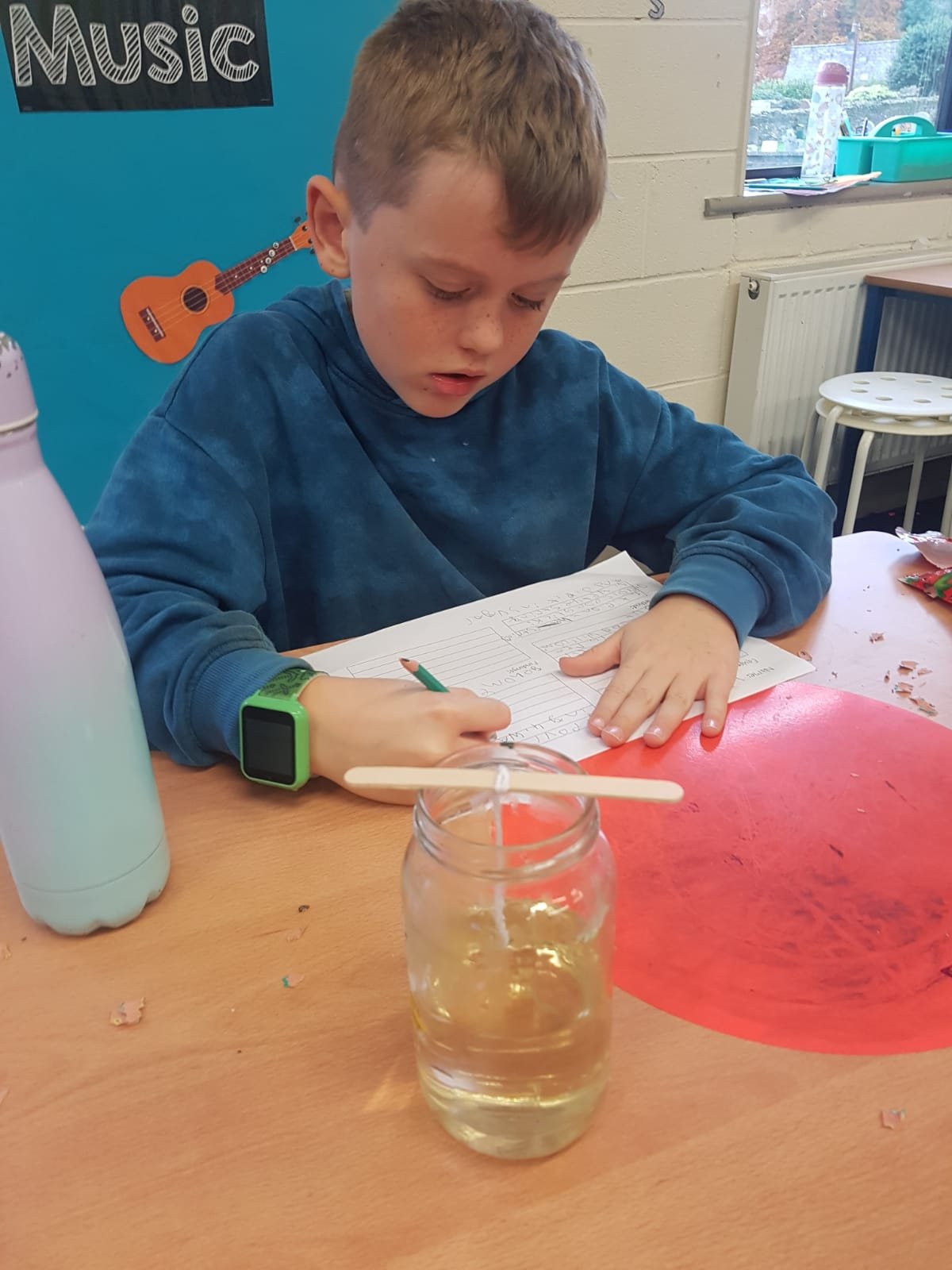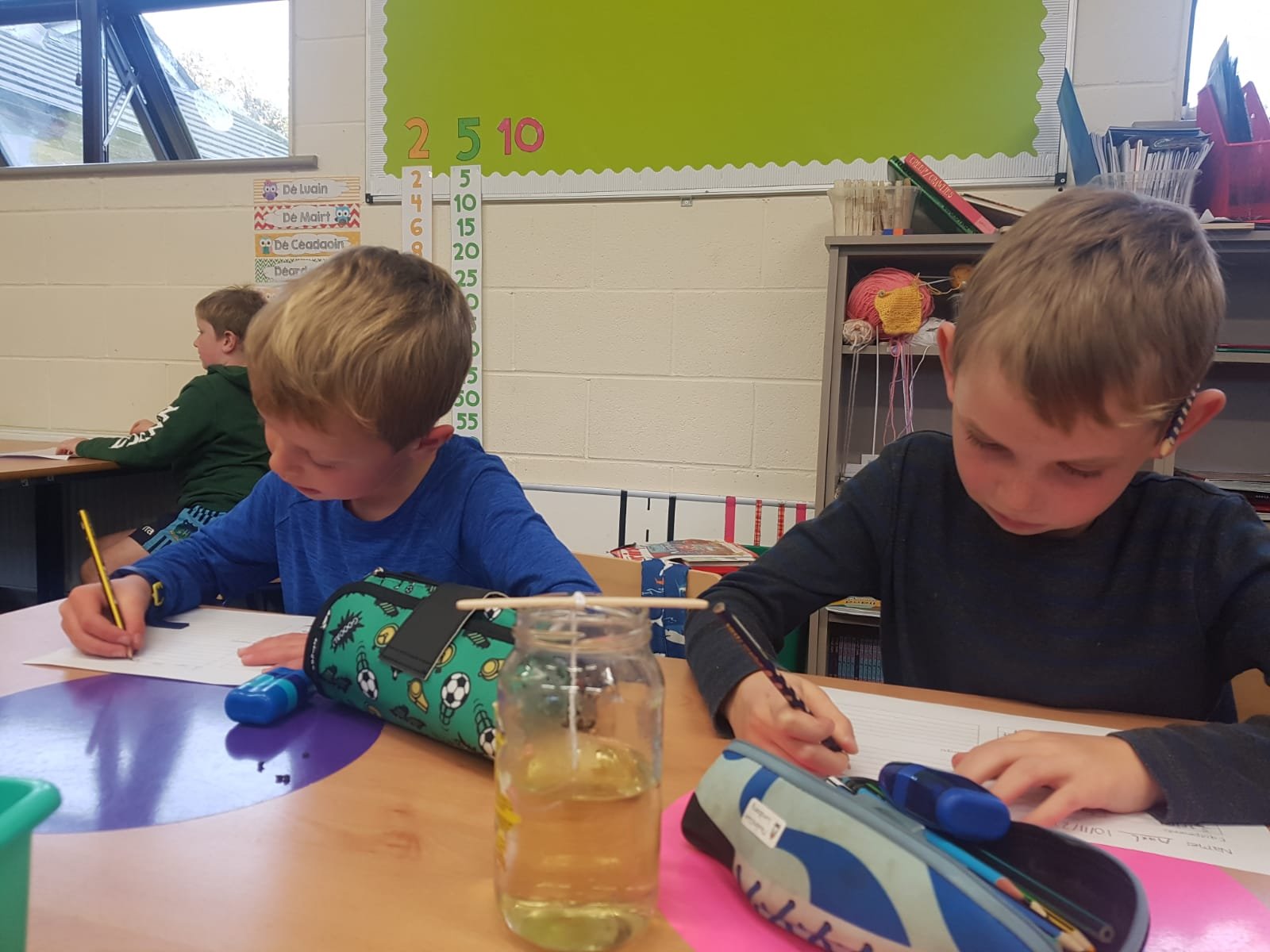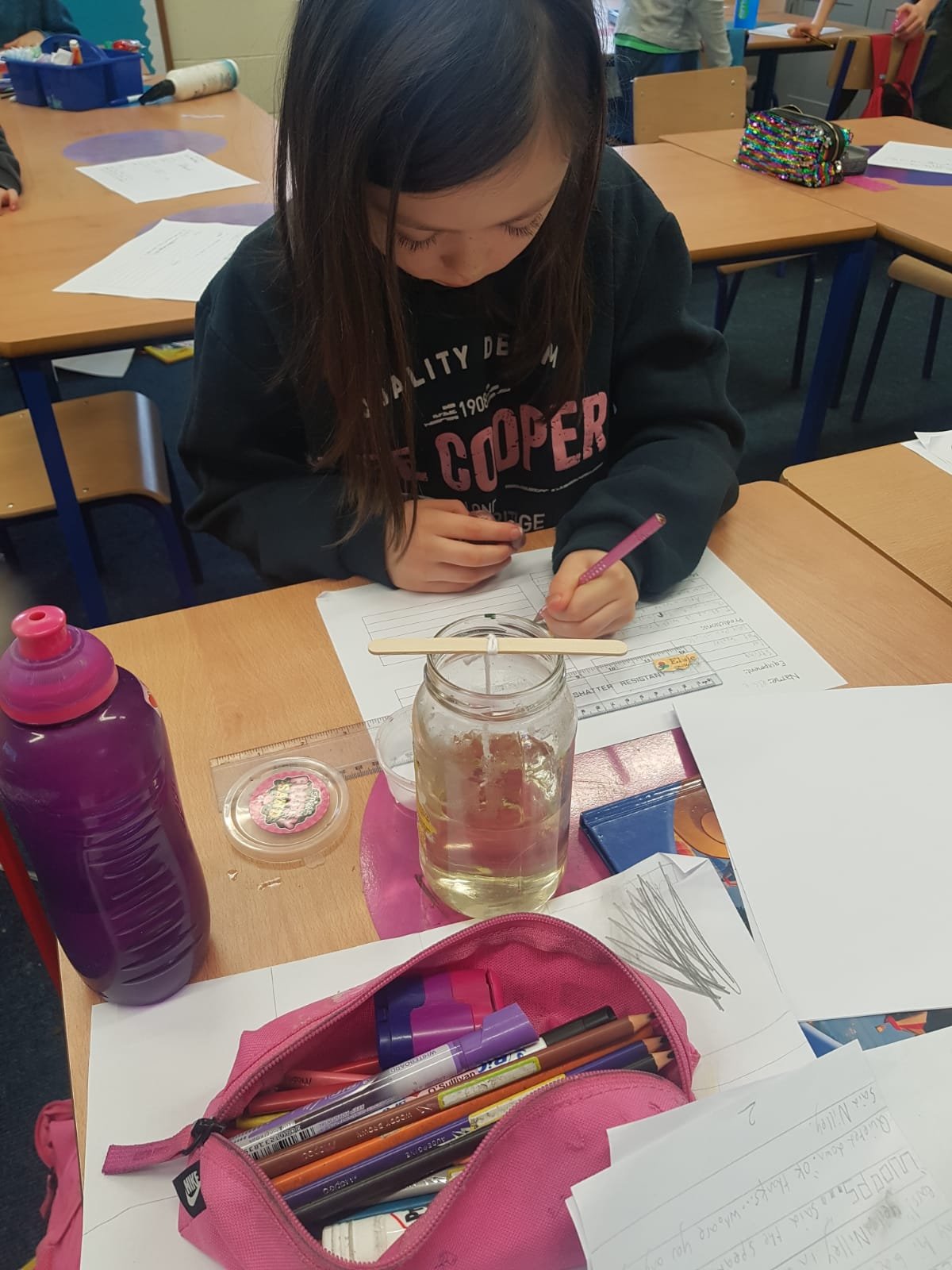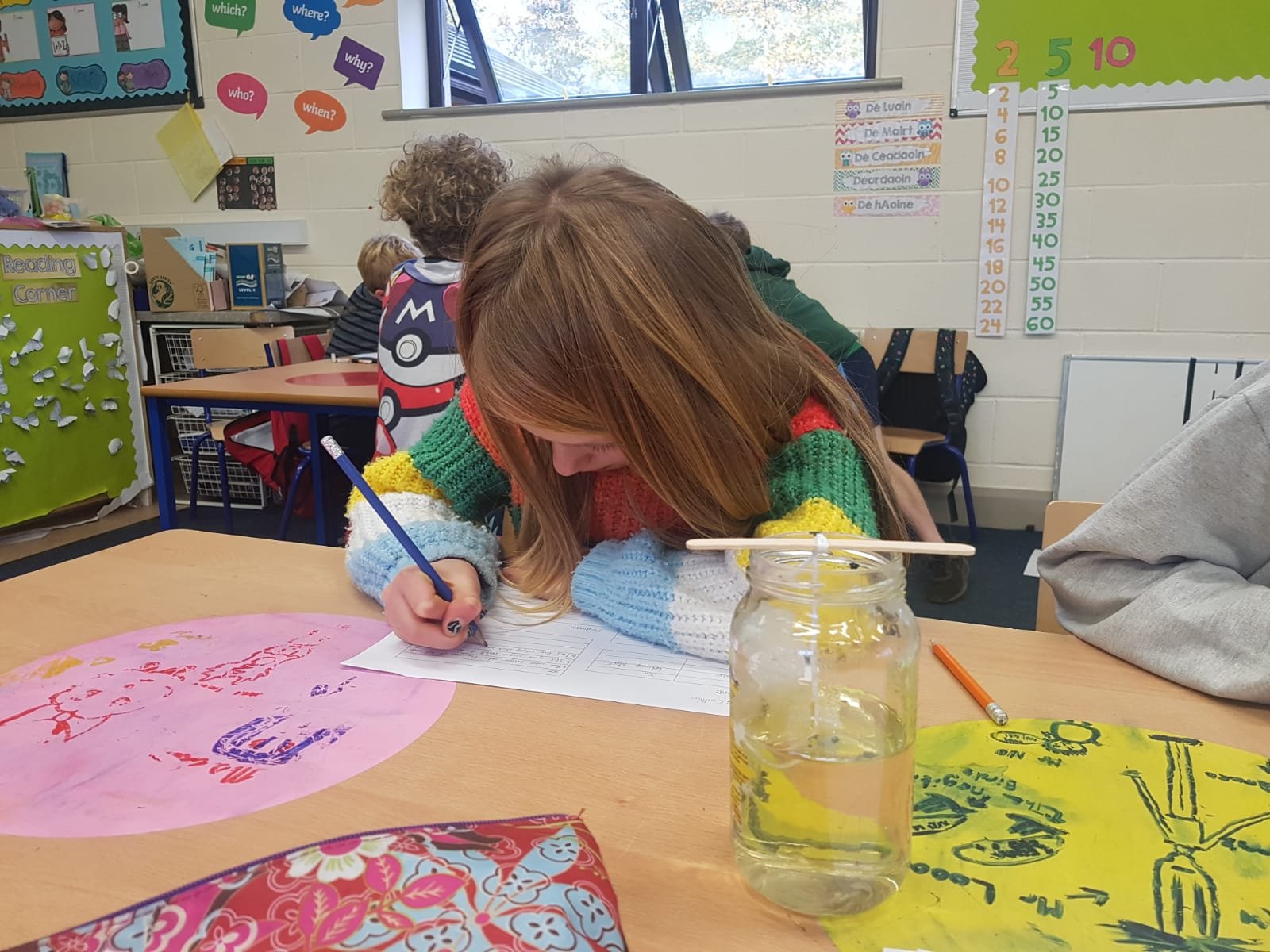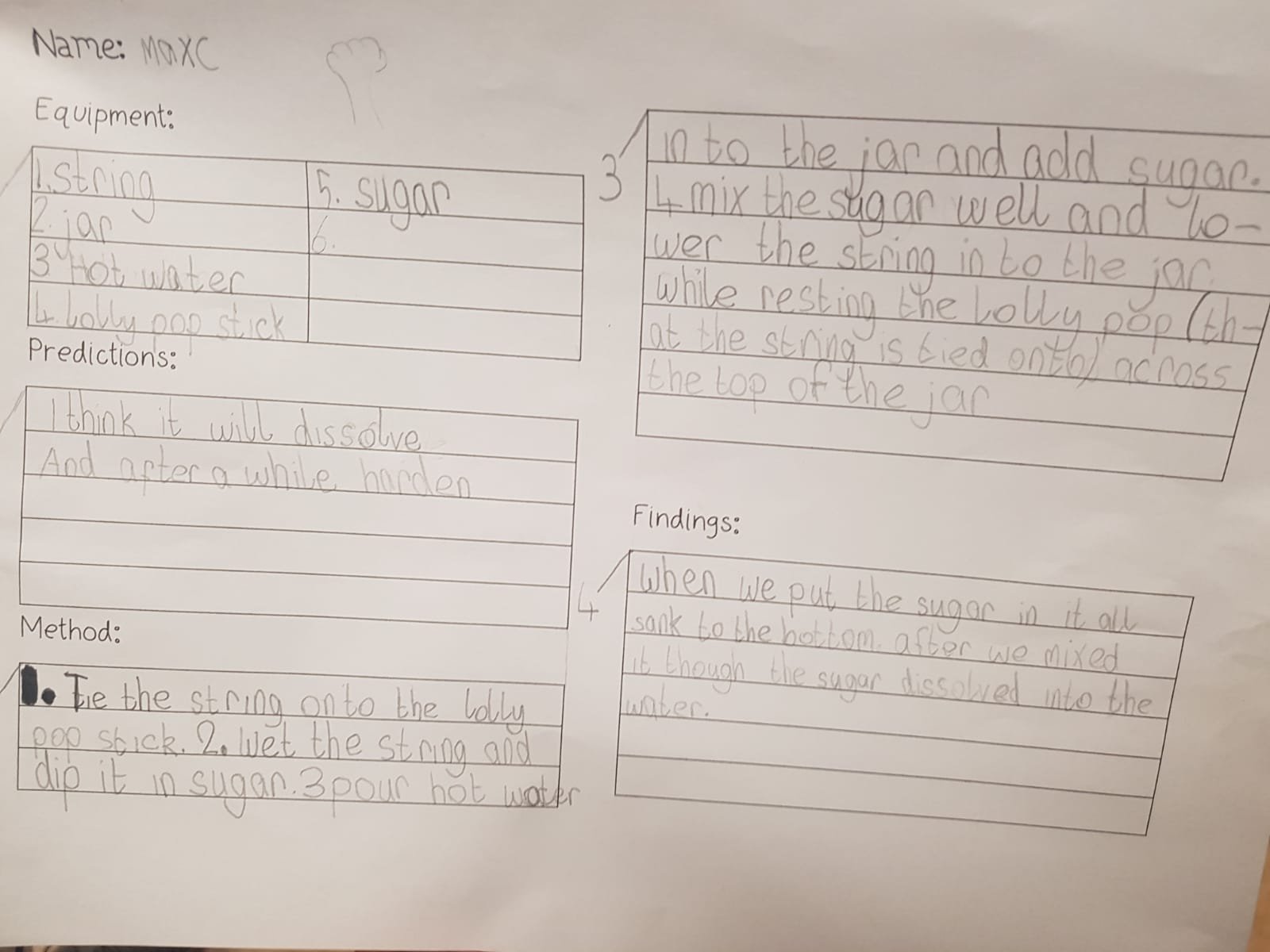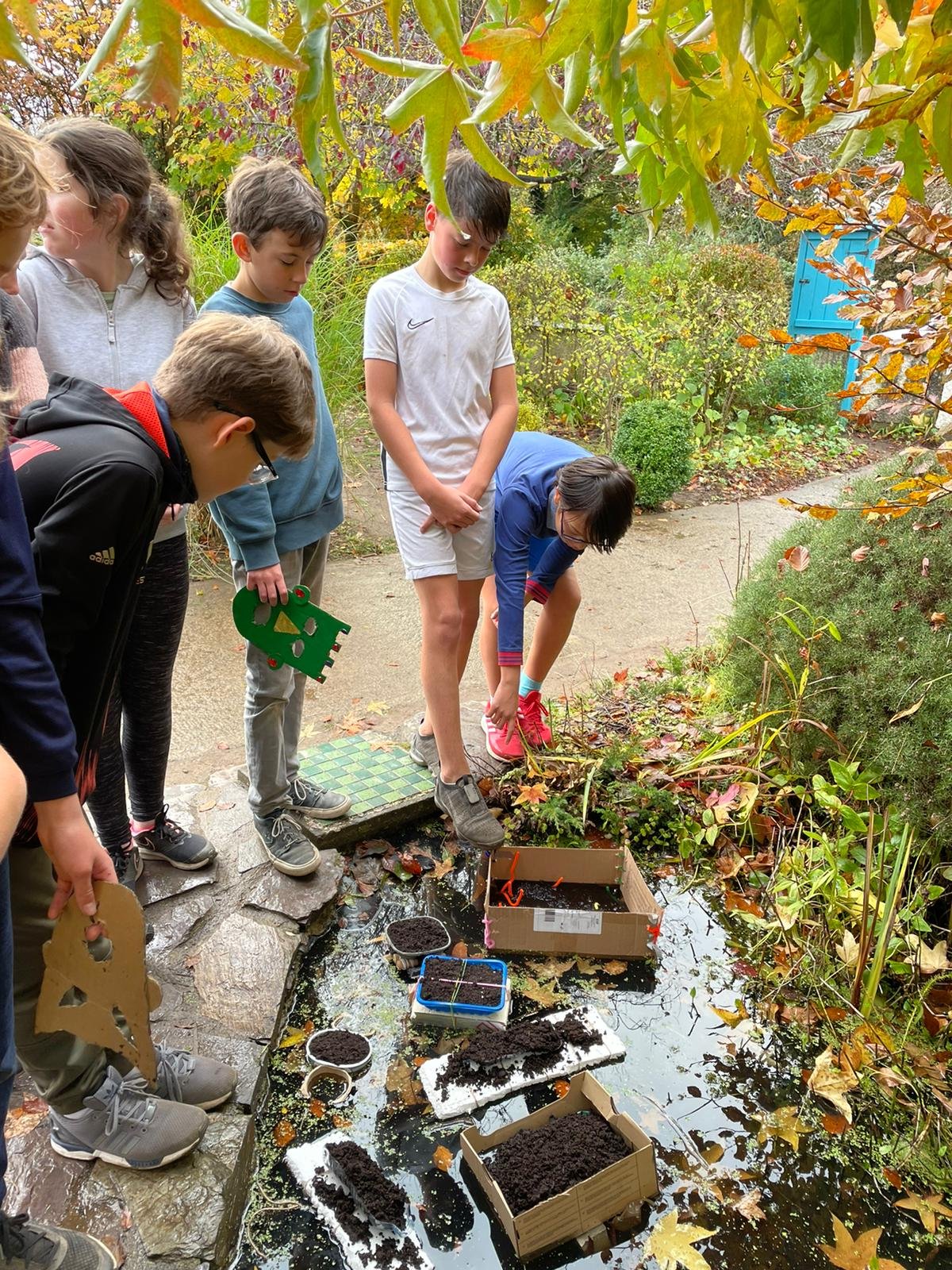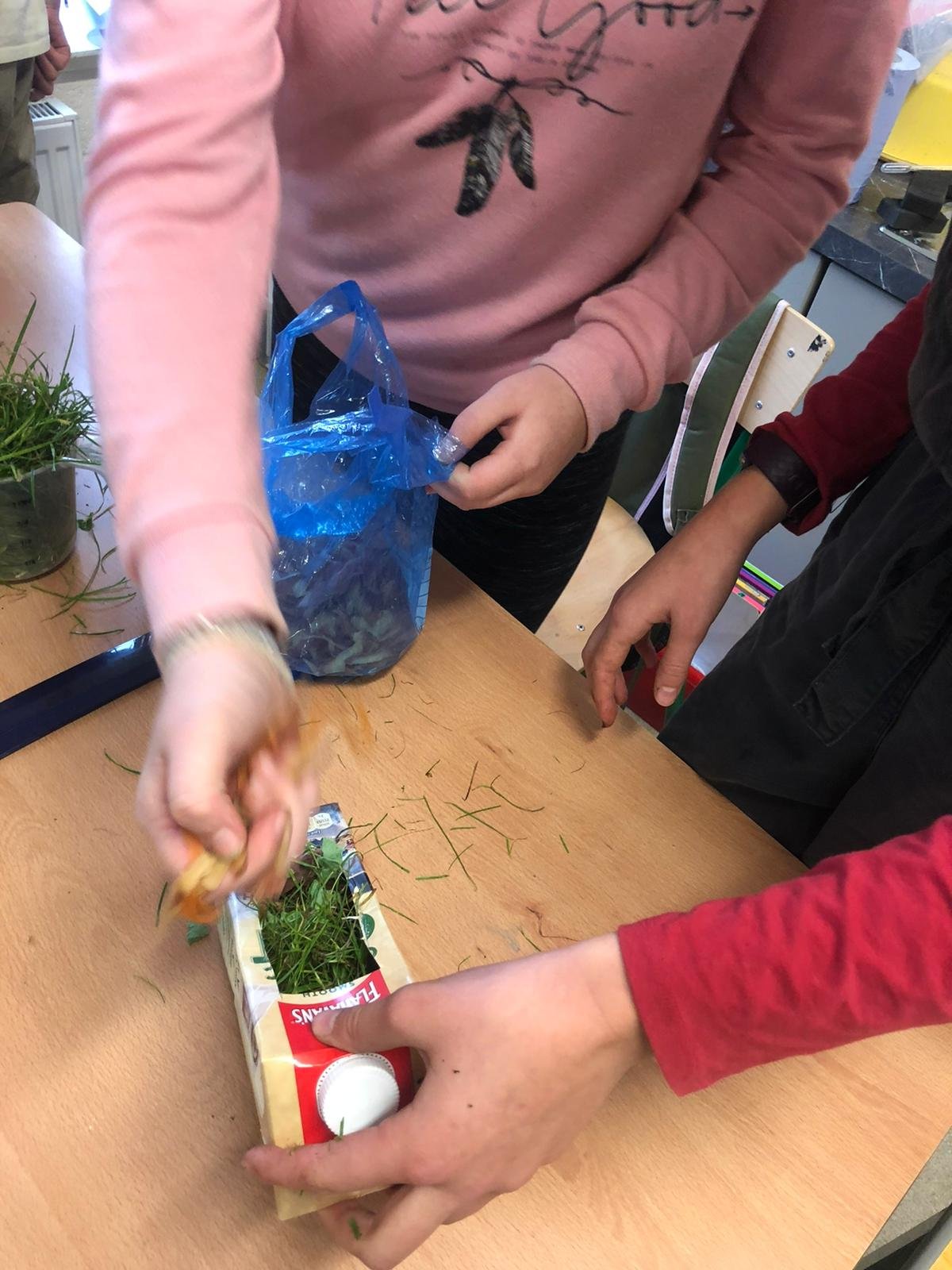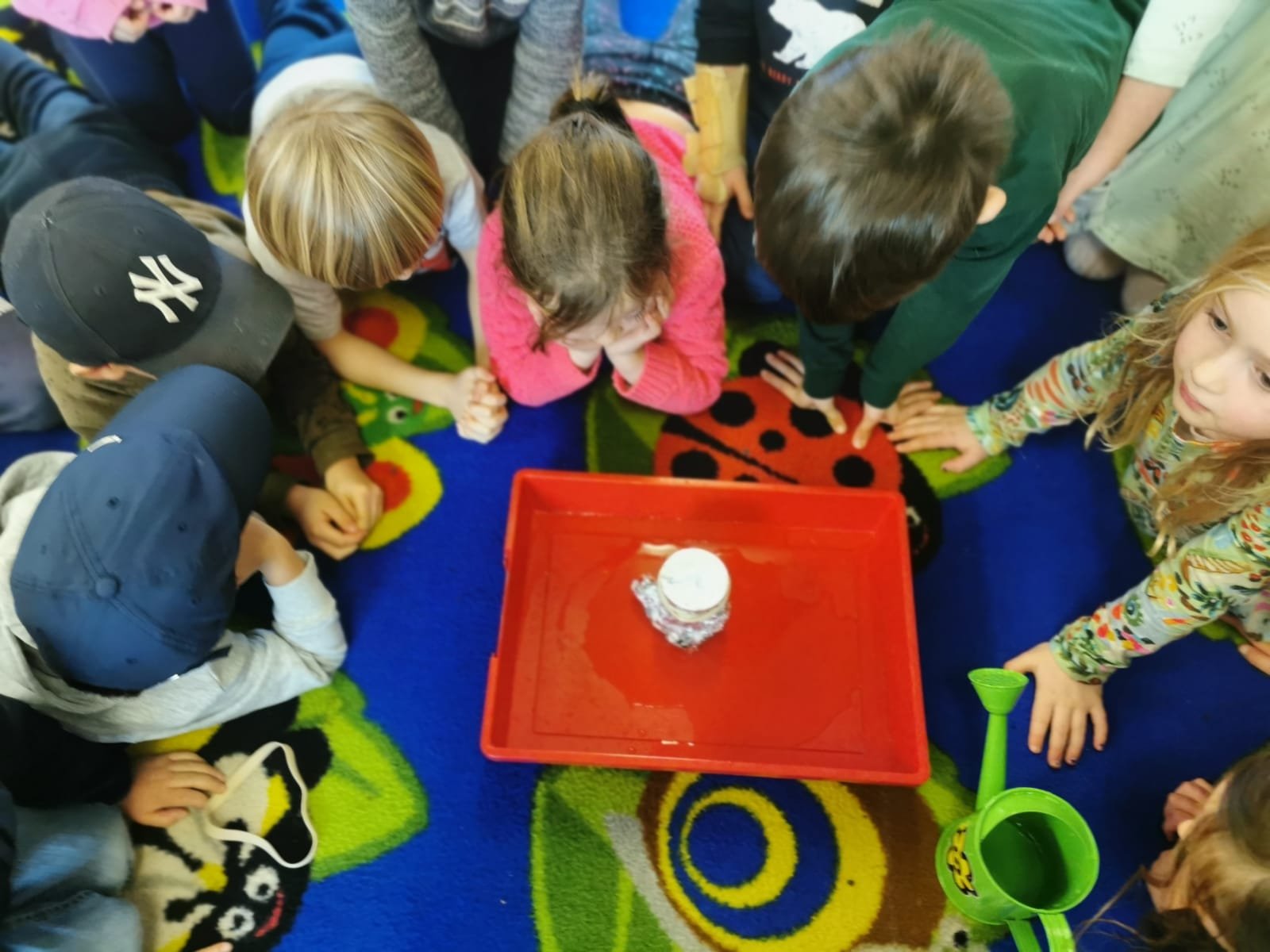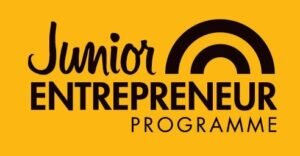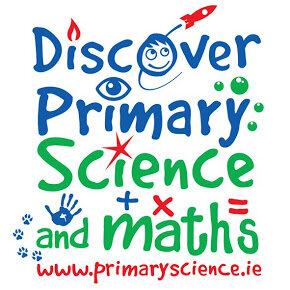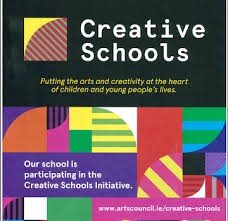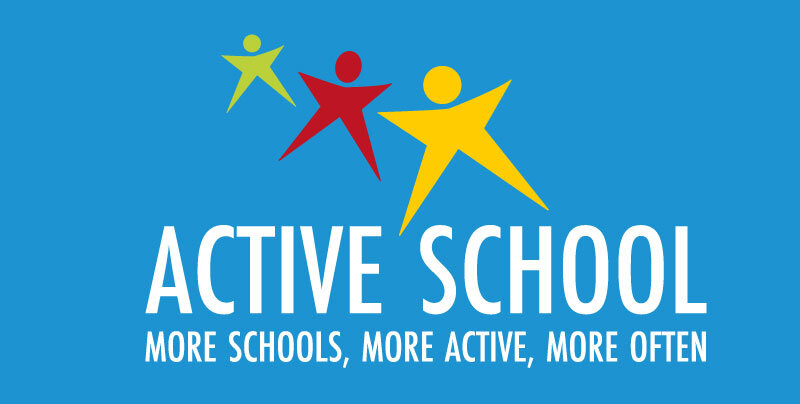Today 2nd and 3rd started their sugar crystal experiment. We learned how to start writing up experiments so wrote a list of the equipment, the predictions we had and then the method involved. We had lots of different predictions about what would happen, but we will have to wait a few more days to see if we managed to grow any crystals! Watch this space for our updates!
Refraction in Action
The children in 4th and 5th class were spellbound by fraction in action today.
The children drew a picture on a piece of paper and sealed it into a clear plastic pocket. They outlined their picture on the outside of the plastic bag and then placed in into a tub of water. What they observed was magic!
When the pictures went into the water the light was refracted as it passed through the liquid. The result was that the colour in their pictures appeared to disappear, as if by magic!
STEM in First class!
The boys and girls in 1st class were given a very tricky challenge today - to create a tower, using only spaghetti and marshmallows, that was as tall as possible and strong enough hold a packet of buttons. The task was very tricky and required lots of communication within the groups, forward planning and cooperation and team work! Well done to all the children and their efforts!
Cress Seeds Experiment
The children in Senior infants are investigating just what plants need to grow this week. After discussions, they decided that they need somewhere safe to grow with lots of light and water. We decided to put this to the test to see if we are right!
We planted 4 sets of cress seeds: 1 set which has no soil but has light and water, another which has no water but has soil and light, another set which has soil and water but no light and the last set has all variables present. We predict that the seeds that have water, soil and light will grow the best. What do you think? Check back to see how our seeds grow over the next two weeks to see if we are right!
The Aztecs
Our senior classes have been learning all about the Aztecs over the last few weeks.
The children have used their creative juices to create some very colourful Aztec inspired face masks.
While learning about the Aztecs, we learned about their chinampas - or floating gardens, and we decide to see if we could design our own. We used a variety of recyclable materials and created structures that not only needed to float, but needed to float while holding a large amount of soil inside. We used our school pond to test our chinampas to see if they would float and were delighted to see that most did!
Skittle Challenge
The Junior Infants had more fun today with exploring colours and colour mixing! We did the skittles challenge - a simple, yet fun experiment where adding water to skittle causes the colour in their shell to dissolve and creates a really amazing display of colours. You can hear the excitement in the children’s voices watching the colours run into each other and create a rainbow!
We made simple recordings of our findings from our experiment too. We noted what we saw at the start and what we saw at the end and used these to help us describe the changes!
Changing state of chocolate
The Junior Infants discovered that when we had heat to chocolate it melts! We made cookies of aliens and planets and decorated them with chocolate and sprinkles afterwards. We decided it would be easier to decorate them if the chocolate was melted so we heated it in the microwave and discovered that it turned from a solid into a liquid in the process. We had lots of fun decorating our cookies and we also discovered that the chocolate tastes just as good when its a liquid as it does when its a solid!
Compost Bins
The children in 5th and 6th have been learning about renewable and non renewable natural resources. Soil is non renewable but it can last for hundreds of years if cared for. We decided to make compost bins so show how we can care for the soil.
We recycled waxed cartons and created two translucent windows (so we can see what is happening Inside the carton). We added soil and some worms to help look after the soil and keep it in good condition. We ensured that each side had 3 air holes for the soil and worms to breathe. Once the bin structure was ready the children added in vegetable peelings they had brought in from home along with some grass. They were careful to layer the contents carefully to ensure that the materials were evenly spread throughout the bins. The last step was to place the worms on top.
We are looking forward to being able to observe the composting process first hand and we hope that it will inspire lots of you to also do this in your homes!
Rocket Launch
The children in 2nd and 3rd class were attempting to fly to space this week! The children have been working hard to design and create their very own rockets!
The children were all given the challenge to build and launch a rocket. To make it a fair test, each child had the same materials, 1 piece of paper and 1 paper straw, to build their rocket. The children tested different options before deciding on their designs. Once built, we tried launching the rockets outside. We discussed ways that we could make sure it was a fair test-all launching from the same height and angle. The children then took turns launching their rockets!
Getting Some Exercise in 2nd and 3rd class
2nd and 3rd class have been looking at the effects exercise has on our body. We know that exercise is good for us and it helps to keep us healthy, but how?
Firstly we measured our heart rate when we were sitting down and relaxed before exercising. We noted how many times our hearts took a beat in one minute.
After this we did some exercises like jumping jacks for a minute and then we measured our heart rates again.
Everyone found that the result was that their hearts were beating faster. Lots of the children also noticed that their breathing was quicker and their body temperature had increased too. The discussions that followed lead us to the conclusion that when we exercise, our hearts beat faster and our lungs work harder. This is because when we exercise our blood flows faster and we breath quicker and the result of this is that our lungs and our hearts get exercise. Just like the muscles in our arms and legs, our heart is a muscle too and it needs exercise! When it pumps faster, we know its getting some exercise and we need to make sure it gets exercise every day!
Teddy Experiment in Senior Infants
Senior Infants were required to come to Teddy’s rescue this week. Poor Teddy was caught in the rain and he was so sad that he got wet! So he asked for our help to find a material to make his umbrella from that would keep him dry when it rains again!
So we set to work! We gathered lots of different materials and we tested them to see if they would keep teddy dry. We tried paper, fabric, plastic, tin foil, cardboard and even cotton wool. We found that materials that were made of plastic, like cling film, kept teddy dry as the rain water didn’t go through. Unfortunately materials like paper, cardboard and fabric were not very good at keeping teddy dry as the water soaked through and made him wet!
Bug Hotels in 1st class
1st class have been investigating the bugs and critters that we share our school garden with. We took a walk around the school garden and found some insects living out there. Some of them were in dark and damp places, others were out in the open.
We had some recycling materials in our classroom so we worked together to try to create a habitat for the insects in our garden. Using our materials we made some really lovely bug hotels that we think the bugs in our garden will be happy to sleep in!
Nocturnal Animals
The Junior infants read a new story this week. It was the well known and much loved ‘Owl Babies’ by Martin Waddell and Patrick Benson.
After reading the story the children were struck by something and posed an interesting question - why were the owl babies awake at night time?
So we decided to investigate! We knew that some animals, like hedgehogs are nocturnal, because we learned about that when we were investigating autumn. So we surmised that if the owls were awake during the night time too, then that must mean they are also nocturnal. From here we went investigating, with our teachers help, to find some more nocturnal animals and we found that there are lots. From cats, to mice, badgers and deer, there are lots of nocturnal animals that share our world.
We learned a very interesting new word too - diurnal. This means animals and people who sleep during the night and wake up during the day - like us! We are diurnal, the opposite of nocturnal. To put our new knowledge into practice we completed a sorting activity.
We had some glow sticks left over from our Halloween party so we pulled down all the blinds in our classroom to make it dark, like it is for nocturnal animals. We then activated our glow sticks but we will leave understanding that chemical reaction for science week another year!
Colour Mixing
The Junior and Senior Infants have had lots of fun exploring colours this week.
The Junior infants have been learning all about the three primary colours. They have also been exploring the superpowers that these colours have - did you know that when two super colours meet they magically create a new colour? The Junior Infants had lots of fun exploring these new colours by mixing paints and creating some lovely paintings.
The Senior Infants revisited the concept of primary and secondary colours and explored colours mixing through a different medium. The Senior infants observed what happened when 3 cups of coloured water were connected to each other with sheets of kitchen roll. They observed the water being absorbed by the tissue and when two different colours met and blended, it created a secondary colour, just as it did when the Junior Infants mixed the paint. The walking water experiment proved to have super powers just like paint!
5th and 6th Class STEM Challenge
The children in 5th and 6th class were set a challenge:
Can you create a house that is suitable for a tropical climate?
From their studies of tropical climates, the children knew that these climates are very wet, so their house would need to be able to sustain high levels of rain. The children worked in small groups to try and create a house that would keep the contents inside dry. Their houses also had other features such as being raised on stilts as areas in the tropics flood regurally. The children were given no direction with materials and had to come up with materials they felt would be suitable themselves and give reasons why. There was a lot of discussion, listening and compromising within the groups as the children worked through the challenge with the aim of being successful in their task.
Each group were very excited to test their houses by simulating rain and then checking to see if the tissue inside remained dry.
Paper rollercoaster design
Today 5th class finished maths week off with the paper rollercoaster challenge.
Challenge: The group were challenged to make the tallest rollercoaster which would function without a problem. Groups were given 3- seconds to complete the challenge. Look below to see our creations.
Process: The groups explored using different shapes - looking at tunnels and open tracks. They then faced the problem of supporting these rollercoasters using paper and selotape alone. We agreed that we would use marbles at the beginning of our work to ensure it was a fair test.
Results:
When testing this we agreed that groups would be given three turns at working their rollercoaster to demonstrate how well it worked. Where rollercoasters did not completely work, we measured the descent from beginning until the marble popped out.
The winning rollercoaster to function totalled 1 metre and 10 cms with an impressive ability to support itself. We did question the independence of this structure as we queried whether the tracks did indeed touch the sink bowl for support when under pressure but as you can see in the picture below the rollercoaster was able to hold its own weight when the marble was travelling.
Conclusion:
Groups who worked concurrently on building the track and supports were most successful. Many really long tracks failed to hold the marble for its journey as they were not supported well enough.
Maths Week games and Challenges
This week we are enjoying completing some maths games and challenges. This morning Ms Ward’s groups had great fun completing the emoji equations and shape memory games on the whiteboard. The resources are all available on mathsweek.ie and you can give these challenges a go for yourself by visiting their website. Our 5th class group were most fond of the emoji equations.
Meanwhile some of our senior pupils put their furniture assembly skills together in making our new flat pack furniture.
Marshmallows and Spaghetti STEM challenge in 4th and 5th















4th and 5th class were tasked with designing and making a tower using only spaghetti and marshmallows. The challenge was to design and make a tower to hold a copy book on top for 10 seconds, with the tallest tower being rewarded with some Cadbury Heroes. Groups were given 30 minutes to complete the task.
We were thrilled to see that 7 our of our 9 towers were successful in supporting the copy book for the 10 seconds, some for as long as 6 minutes before we took the copy off. It then came down to seeing which tower was the highest - with our highest tower measuring in at an impressive 46cm. Look at a video we made to show the last ten seconds of our tower holding the copy book.
Making weather instruments in 4th & 5th class






Today 4th and 5th class made some weather instruments to measure the weather. Among our creations we have a wind vane, a barometer and a rain gauge.
Wind vane: We used some laminated card to catch the wind and some straws/lollipop sticks to hold these on. We will place our different vanes in different areas around the school to compare parts that may be more and less windy and to see if the vane is always pointing the same direction in all locations. Will the wind change direction much during the day/week.
Barometer: We also made a barometer to measure the pressure in the atmosphere. We used a balloon, a straw, a glass jar and some paper card.
Anemometer: We designed and made an anemometer to measure wind speed and direction. We used some paper cups to catch the wind and spin. We will count the number of times the cups spin around to make a full rotation. To help us with this, we coloured one of the cups black.
Rain gauge: We used a plastic bottle with the top cut off to make a funnel. We marked our measurements on the side. We were very resourceful and borrowed some spoons from the staff room to dig a hole to sit the rain gauge into.
We will be observing our instruments carefully this coming week and recording our weather at the same time each day to ensure we are as accurate as possible.
Discovery Primary Science Award 2021
We are delighted to announce that we have been awarded our 7th Discovery Primary Science Award - an award given to schools in recognition of an outstanding commitment to the teaching of science, STEM, maths and engineering. Below is what the committee had to say on our application:
“Well done Nun’s Cross National School. A very comprehensive log of all the activities undertaken in each class in each category during the year and clearly presented and labelled. So many wonderful examples of STEM - your Viking video, your Earth Promises, your use of the new ipads, your artwork associated with projects (penguins, stained glass, lego rainforest models. You seemed to get great value from SeeSaw - particularly liked the kitchen measuring video with the little puppy looking on!
You should certainly apply for the Badge of Excellence next year. it has a slightly different focus but well within your capabilities
Congratulations on this year’s award.”
Below is a sample of some of of our work across the school which has helped us achieve our award!
Congratulations to the children and teachers on their achievement!

